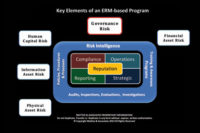How to Keep Up with Emerging Technologies and Risks
consumers hundreds of billions of dollars annually. In the United States, credit card fraud resulting from cyber intrusions has skyrocketed.

We live in a world of rapid technological advancements which generate significant opportunities and advantages but also creates significant risks. It’s hard to imagine that just 100 years ago when you went to town for supplies you most likely would have walked, ridden a horse or rode on an ox-drawn cart. A trek across country was a multi-day adventure on a steam locomotive. Kerosene lamps were used to light most homes, and electricity was just beginning to make its debut.
Today, people get in their car for a short hop to the grocery store or fast food restaurant for breakfast, lunch or dinner. The longest coast to coast airline route is just over six hours in length... a shorter time than it used to take most people to ride into town in their horse-drawn carriage.
While technological advances have greatly contributed to our comfort, economic growth and general well-being, there are also some major risks that have evolved which threaten our economic stability and resiliency. The ever-rising tidal wave of cyber-based crime costs businesses, communities and consumers hundreds of billions of dollars annually.
In the United States, credit card fraud resulting from cyber intrusions has skyrocketed. U.S.-based credit card companies and retail establishments have resisted adopting secure chip and PIN technology because of higher costs for the card itself and having to replace all point of sale terminals to accept this new technology. However, the resulting write-off of fraudulent credit card charges is simply passed on to the consumer through higher fees charged to business establishments accepting the cards.
Ironically, the cost of replacing current credit cards and point of sale terminal technology that is based on the highly secure chip and PIN technology would be offset by the reduction in fraudulent charges being written off within a couple of years. Moving to chip and PIN technology on credit cards issued across most of the rest of the world has already been proven to reduce credit card fraud to a negligible level. Reluctance on adopting new technology in the credit card industry has resulted in significantly higher risks and associated costs to banks, businesses and consumers.
Sophisticated hackers constantly test firewalls for vulnerabilities that can be exploited. As has been painfully evident in many recent attacks, hackers have targeted third-party suppliers, law offices and service providers that typically have a third-party connection to a larger enterprise’s network. Any good cyber warrior will tell you that major computer systems and networks are only as secure as their weakest link. Typically, smaller enterprises do not maintain a robust cybersecurity posture, which increases their vulnerability to attack and to becoming a portal to larger enterprise networks and systems.
Another area of significant risk in virtually every segment is the rapid development of new technologies, which provide dramatic enhancements to the customer experience. These emerging technologies can catch companies unprepared to defend their market share in their given field of operation. Few companies have sophisticated intelligence-gathering programs in place that include monitoring for the first signs of new and potentially game-changing technologies being developed and tested.
Let’s take a moment to reflect on a nostalgic trip down technology lane. Companies in the carbon paper business were fat, dumb and happy until the word processor took hold. Corrections to forms, letters and entire documents were suddenly easier to make, and the noticeable productivity gains not only resulted in the demise of the carbon paper franchise, but typewriters suddenly were also relegated to the outdated technology pile.
Companies are not the only ones that must monitor developments in new and emerging technologies. In the 1980s the emergence of Stealth technology significantly altered the balance on the battle front. The use of radar as an early warning system by adversaries to detect intrusions into their airspace was rendered virtually obsolete. The rapid adaptation of the types of IEDs deployed tilted the advantage in both Iraq and Afghanistan to the insurgents until new IED detection and protection methods were developed by the military.
Whether you are with a company or the government, developing a solid base of intelligence on new and emerging technologies is a critical element in developing strategic and tactical responses to maintain continuity of operations. Alexander the Great said it best...“It’s pardonable to be defeated, but never to be surprised.”
About the Authors: Jerry J. Brennan is the founder and Chief Operating Officer of Security Management Resources (SMR Group), the world’s leading executive search firm exclusively focused in corporate security. Lynn Mattice is Managing Director of Mattice and Associates, a management consultancy focused at the development and alignment of Enterprise Risk Management and Business Intelligence Programs, as well as Intellectual Property Protection and Cybersecurity.
Looking for a reprint of this article?
From high-res PDFs to custom plaques, order your copy today!






